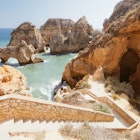
Unforgettable experiences off the beaten path in Spain
Apr 19, 2021 • 7 min read

Countless rewarding experiences await travelers who venture off the beaten path in Spain © RudiErnst / Shutterstock
Few countries in Europe are as sophisticated and diverse as Spain when it comes to nature, culture and cuisine.
And while major destinations such as Barcelona, Madrid, Seville and Bilbao may draw the most visitors, countless rewarding experiences await travelers who venture off the beaten path.
Whether you’re drawn by deserted, wave-battered cliffs and beaches, hidden coves, desert and salt flats, tranquil mountain valleys, or timeless villages replete with historic architecture, Spain delivers. Here are 10 of our favorite remote corners of the country, each paired with the region’s typical cuisine.

Valles de Hecho & Ansó
In the northernmost corner of Aragón, these picturesque parallel river valleys offer unparalleled access to the Pyrenees. Surrounded by craggy peaks and fringed by dense woodland, Valles de Hecho and Ansó feature three ancient stone-built villages – Hecho and Siresa in the former and Ansó in the latter – with cozy guesthouses and hotels that cater to dedicated hikers. Whether you’re looking to bag some of the surrounding peaks – Bisaurín (8760ft), Meseta d’os Tres Rais (8031ft), Castiello d’Archer (7822ft) – or whether gentler riverside walks or ambles through the Selva de Oza are more your pace, you’re likely to find what you’re looking for.
Get a taste: Aragón is renowned for its hearty meat dishes, from grilled venison to the typical Aragonese pollo a la chilindrón (chicken stew). Don’t miss the locally brewed Pirineos craft beer.

Cistercian Route
La Ruta de Cister – a 65-mile circular hiking route – connects three of Catalonia’s most spectacular Cistercian monasteries: Santa Maria de Poblet, Santes Creus and Santa Maria de Vallbona. Accessed from Lleida or Tarragona, the three-day hike allows you to fully appreciate the Catalonian countryside and its varied scenery: the L’Alt Camp flatlands and the jagged El Cogulló rocky ridge on the approach to the Santes Creus monastery; the vineyards of La Conca surrounding Vallbona; and the wooded hills fringing Poblet. Don’t miss the Gothic cloister and restored royal tombs of Poblet, Vallbona’s nunnery, or the beautiful mix of architectural styles that makes up the Santes Creus monastery. Nearby, the Priorat wine region produces some of Spain’s best and is particularly known for its full-bodied reds made from garnatxa and cariñena grapes.
Get a taste: Traditional Catalan fare includes grilled meats and artichokes, calçots (grilled baby leeks with Romesco sauce), and crema Catalana – the region’s answer to the crème brulée.

Albarracín
Occupying a narrow rocky ridge high above the Río Guadalaviar, its pink-hued stone buildings silhouetted against rugged cliffs, Albarracín is one of Aragón’s most visually striking little towns. Its medieval walls encompass the bend in the river and the centuries-old medieval streets that radiate from the Plaza Mayor. As you stroll the hilly streets, check out the carved wooden balconies, the street lanterns, the stone archways and the splendid coats of arms – some dating back to the 12th century Kingdom of Aragón. Don’t miss the ruins of the 11th century fortress, harking back to the town’s origins as part of an independent Muslim dynasty. For a spectacular panoramic view of Albarracín and the surrounding area, climb the Torre de Doña Blanca at the south end of town.
Get a taste: Albarracín’s restaurants showcase the regional specialties of cabrero lechal (suckling kid), roast lamb and embutidos (cured meats) beautifully.

Cartagena
Inhabited for millennia thanks to its deep natural harbor, Cartagena is one of Spain’s most evocative cities, and it’s easy to explore Cartagena’s ruins on foot. Begin your exploration at the wonderfully intact Roman theatre that dates to the city’s heyday as a strategic port in the Roman Empire. Proceed past the striking Art Deco buildings along Calle Mayor to the remains of the ancient Punic Walls, get a glimpse of the life of a wealthy Roman merchant inside the Casa de la Fortuna and then climb up to the Castillo de Concepción, the 13th century castle that changed hands when King Alfonso X of Castille conquered Cartagena from the Moors in 1245.
Get a taste: Don’t leave the city without trying its signature dish: the caldero – an intensely flavored, slow-cooked rice and fish dish.

Cabo de Gata & Almeria
Comprising some 130 square miles of dramatic, rocky coastline, hidden coves, lapped at by turquoise waters, salt flats, scrubland-dotted desert, and a handful of white villages, Parque Natural Cabo de Gata is one of the most unique corners of Andalusia. Pristine and unpeopled beaches aside, there are numerous walking trails, which you’ll have practically to yourself, while the coastal villages act as hubs for water sports – kayaking, sailing diving – during the summer months. The nearest city to Cabo de Gata is Almeria, a lively port city with a Moorish flavor, whose 10th century Alcazaba – Moorish fortress – is alone worth a visit.
Get a taste: While Cabo de Gata’s villages tend to serve mostly grilled fish and seafood, Almeria’s dining scene includes Moroccan-style tagines.

Cazorla
Dominated by the Castillo de la Yedra with its prominent tower, Cazorla is an attractive pueblo blanco that nestles amidst olive groves on the edge of the Parque Natural Sierras de Cazorla – Spain’s largest protected area. Arranged around three lively squares, connected by a labyrinth of serpentine, narrow lanes, Cazorla is appealing enough to warrant exploration in its own right, though it’s also the popular jumping-off spot for visiting the nearby mountains, waterfalls, river valleys and forests. Trails can be explored on foot, by bicycle and on horseback.
Get a taste: Traditional Cazorla fare is centred on lomo de orza (spiced pork) and grilled or stewed game (venison, wild boar).

Sierras Subbéticas
Roughly halfway between Granada and Córdoba, Andalusia’s Parque Natural Sierras Subbéticas comprises limestone crags, green valleys, deep canyons, springs and caves. The park’s attractions are many and varied, from the well-signposted walking trails through holm-oak woods, and the moderately challenging ascent of the Pico de la Tiñosa (5151ft), to the Picacho de la Virgen de la Sierra – a traditional pilgrimage site. Cueva de la Cabra attracts spelunkers, while Los Murciélagos, the park’s most famous cave, is rich in Neolithic art. Base yourself either in the castle-topped, formerly Moorish village of Zuheros, or in the whitewashed Priego de Córdoba.
Get a taste: Treat yourself to the Cordoban specialty of salmorejo – a thick, savory cousin of gazpacho.

Sierra de Francia
Minor roads southwest of Salamanca lead to the Sierra de Francia, a mountainous, remote corner of Castilla y León, studded with timeless stone-and-timber villages. At the heart of this little-trodden slice of wilderness is La Alberca, an appealing village comprising medieval, half-timbered houses that line the cobbled lanes. It makes a fine base for ascending the Peña de Francia (5682ft) and exploring other nearby villages. These include Miranda del Castañar, a huddle of stone houses on a narrow ridge; Mogarraz, with more than 300 portraits of past and present inhabitants scattered about town; and San Martín de Castañar, dominated by a handsome castle.
Get a taste: Embutidos (cured meats) are the specialty here, and don’t miss versos Microbodega, a boutique winery in San Martín de Castañar.

Rías Altas
If driving through Galicia, take the winding, narrow roads along the wild, northernmost stretch of coast from the historic port of A Coruña to Ribadeo. Pass through the estuary port of Betanzos, lingering in taverns over seafood and wine, then pause in Pontedeume to watch fishing boats bob on the bay. Further north, you’ll pass through the Atlantic coastal forest of Parque Natural Fragas do Eume and the small maritime port of Cedeira, beyond which, Galicia’s rugged cliffs and deserted coastline begin in earnest. Detour to Cabo Ortegal to watch the Atlantic break violently against the cliffs and pause at scenic half-moon crescents of sand on your way to the Bares Peninsula, crisscrossed by walking trails and home to the classic, whitewashed fishing villages of Porto de Bares and O Barqueiro.
Get a taste: Galicia is all about seafood, so get your fill of percebes (goose barnacles), ameixas (clams), centollos (spider crabs) and the classic pulpo a feira (octopus slices in olive oil and paprika).

Lekeitio
Sitting above two sandy beaches, this low-key Basque Country town is located halfway between its famous neighbors of Bilbao and San Sebastián. Its historic core is dominated by a Gothic basilica, and its harbor, lined with brightly painted half-timbered buildings, is highly photogenic. One of Lekeitio’s biggest attraction is the Isla de San Nicolás where you can wander at low tide.
Get a taste: Pintxo bars are a Basque Country staple, where you can pair glasses of semi-sparkling txakoli wine with pintxos – tiny, elaborate open sandwiches. It’s a 45-minute drive from Lekeitio to Asador Etxebarri – one of the world’s best restaurants, where everything – from caviar to game – is wood-smoked on the grill.
Explore related stories









